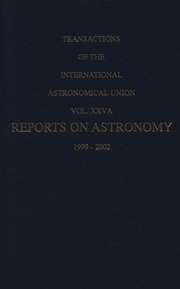No CrossRef data available.
Article contents
Some Aspects of Space Astronomy
Published online by Cambridge University Press: 16 November 2021
Extract
My first encounter with what has come to be known as Space Astronomy took place at the Harvard Observatory in 1937 at a colloquium by Dr M. N. Saha on ‘A Stratosphere Solar Observatory,’ in which he described some of the advantages that astronomy would gain if the solar spectrum could be photographed from a balloon at a height of 40 kilometers, or above what was then thought to be the altitude of the ozone layer. As Saha put it, ‘the great intensity of the Balmer series and the associated continuous spectrum in the chromosphere has given rise to a large number of speculative theories.’ He then went on to suggest that if only the Lyman lines could be observed, the problem of hydrogen excitation in the Sun and stars would probably be completely explained, and the problems of stellar atmospheres would be nearer solution.
- Type
- Invited Discourse B
- Information
- Transactions of the International Astronomical Union , Volume 12 , Issue 1: Reports on Astronomy , 1965 , pp. 775 - 787
- Copyright
- Copyright © Academic Press 1965


